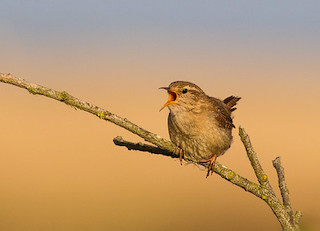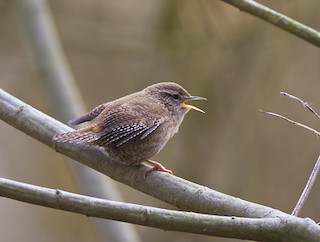 The Wren is the most common breeding bird in Britain.
The Wren is the most common breeding bird in Britain.
Photo: © Natural England/Allan Drewitt
Scientific name: Troglodytes troglodytes
Other common names: Northern Wren, Winter Wren, Eurasian Wren
Cornish name: Gwranen
Conservation status: IUCN Red List, Least Concern.
What to look for:
- Colouring and appearance : Very small, round bird with a slim bill often seen with its tail upturned. Cryptic red-brown colouring with paler throat, barring, and pale line above the eye.
- Size : Length 8 to 12 cm, wingspan 12 to 16 cm, weight 6 to 12 g.
- Where : Many habitats, most frequently woods, but also gardens, moorland and fields. Less abundant in Scotland and the north of England.
- Call : Complex trilling song, that can be heard most of the year.
- Similar species : Goldcrest (which is even smaller), and Dunnock (which also forages close to the ground).
 It may be a diminutive bird, but the Wren’s familiar and high-spirited song is one of the loudest of the dawn chorus. Relative to its size, its call is ten times more powerful than a rooster.
It may be a diminutive bird, but the Wren’s familiar and high-spirited song is one of the loudest of the dawn chorus. Relative to its size, its call is ten times more powerful than a rooster.
The Wren is a successful bird in the UK – it is our most common breeding bird, with over 8.5 million breeding territories – although it suffers in harsh winters because of its size and lack of availability of its insect prey. Its global distribution covers Europe, North America, Canada, North Africa and Asia: it is the only wren species with a natural range outside of the American continent. Despite its abundance, it is not the easiest bird to spot. Not only is it small and brown, but it also hunts for food on or close to the ground, rooting around in vegetation and rotting wood.
 Males build their nests in holes, often in trees or rocks. Each male builds more than one, giving the female a choice. The nest is fairly distinctive, with its side entrance, and is made of a variety of materials, including leaves, grass and hair. Once she has selected her preferred nest, the female lines it with feathers before laying up to nine eggs. Both parents feed the young once they have hatched and until they become independent. A pair of adults may raise as many as three broods in a single season.
Males build their nests in holes, often in trees or rocks. Each male builds more than one, giving the female a choice. The nest is fairly distinctive, with its side entrance, and is made of a variety of materials, including leaves, grass and hair. Once she has selected her preferred nest, the female lines it with feathers before laying up to nine eggs. Both parents feed the young once they have hatched and until they become independent. A pair of adults may raise as many as three broods in a single season.
It’s hardly surprising that a bird as common and familiar in Britain as the Wren is surrounded by folklore, often in association with the Robin. It used to be a common belief that the Robin and the Wren were the male and female of the same species (hence Cock Robin and Jenny Wren). Some myths also give the Wren a ‘tricksy’ personality. One druid legend recounts how the birds had a competition to determine who would be their King by seeing which of them could fly the highest. A Wren hid itself on the back of the Eagle. When the Eagle tired and could fly no more, the Wren flew up from its back and thus claimed the crown.
Did you know…?
…A bit on the side: in the breeding season, females listen to competing males’ songs with interest, and may indulge in copulations with males other than their pair partner. The male is polygynous, mating with several females.
…High-rise: wrens have been found living at over 4,500 m altitude in the Himalayas.
More information and references:
Svensson, L., Mullarney, K., Zetterstrom, D.,1986. Collins Bird Guide, second edition (translated by Christie, D., Svensson, L.). HarperCollins, London.
Published: August 2014
Author: Amanda Scott
Photos: © Natural England/Allan Drewitt
